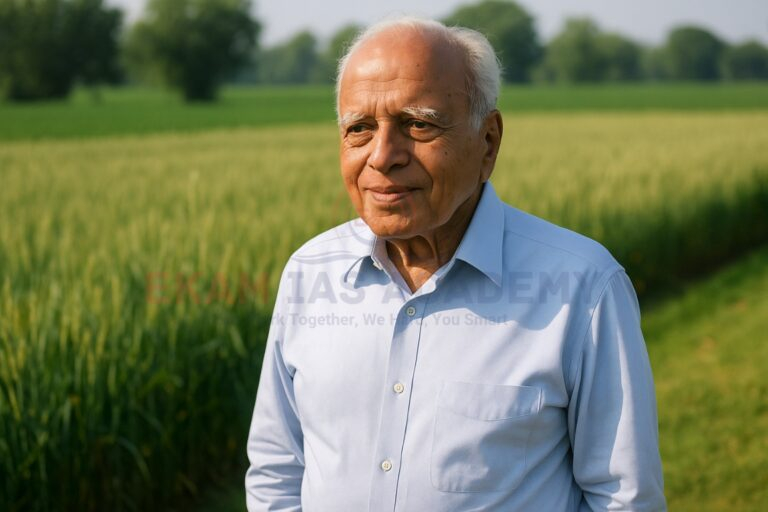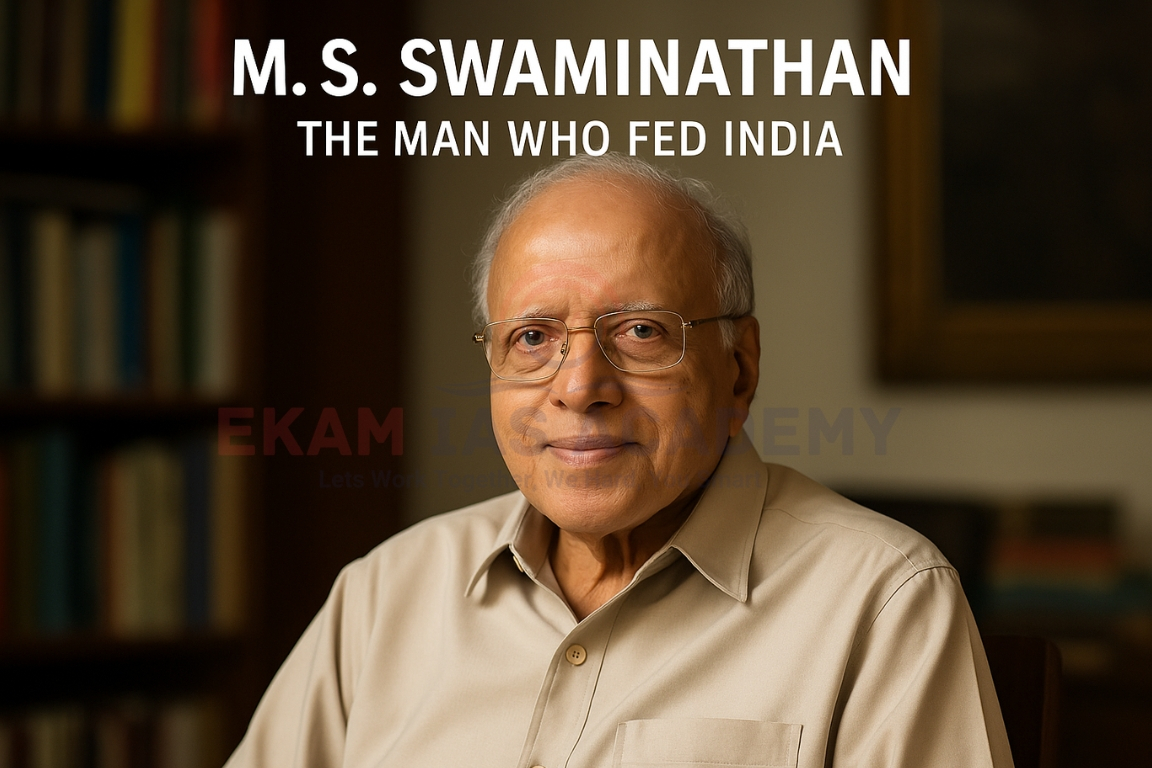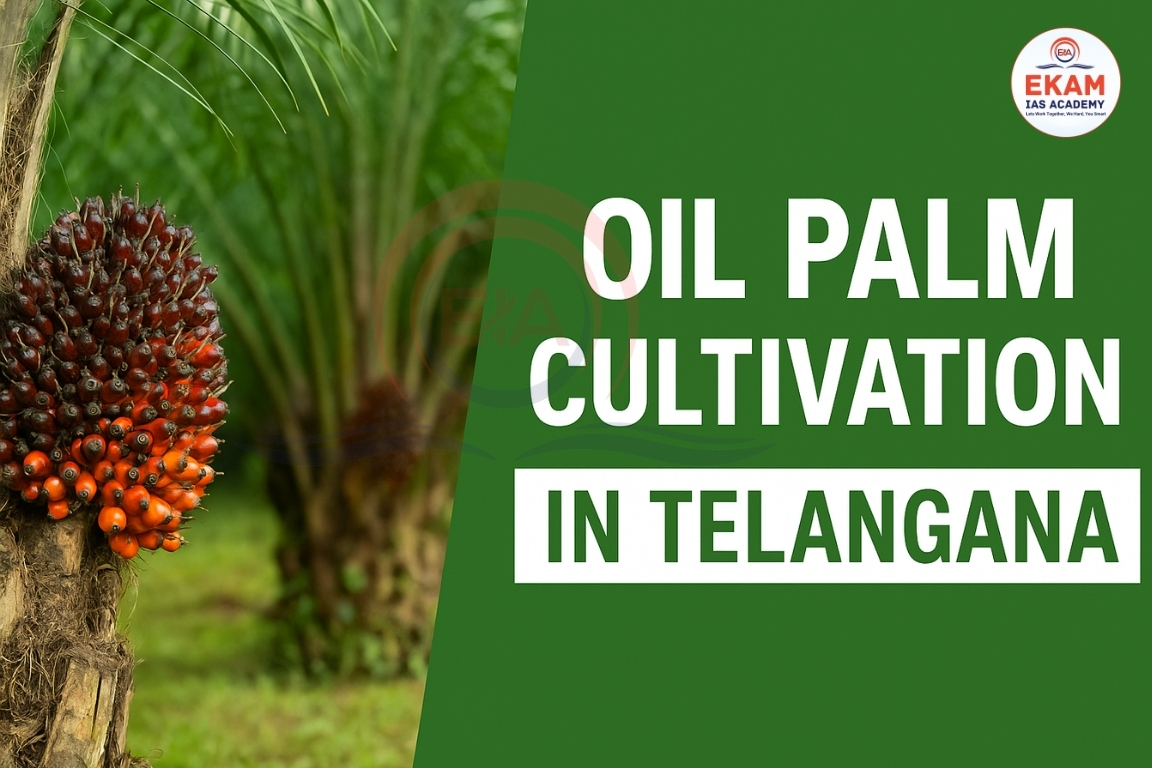This year marks the centenary of M.S. Swaminathan’s birth. A new biography “M.S. Swaminathan: The Man Who Fed India” by Priyambada Jayakumar highlights his role in the Green Revolution and offers lessons for Viksit Bharat.
Green Revolution
- Period during the 1960s–70s when India introduced high-yielding variety (HYV) seeds, irrigation, fertilizers, and pesticides to boost agricultural production.
- To achieve self-sufficiency in food grains and reduce dependence on food imports.
Green Revolution Crops Introduced
- Mainly wheat (e.g., Sonalika, Kalyan Sona).
- Rice (e.g., IR-8, Jaya, Padma).
- Later extended to maize, bajra, and jowar.
- Focus was food grains, not pulses or oilseeds.

Need for Green Revolution
- Severe food shortage in India during 1950s–60s.
- Heavy dependence on food imports under PL-480 from the USA.
- Rising population pressure on agriculture.
- Low productivity due to traditional farming methods.
- To achieve food security & self-reliance.
Contribution to the Green Revolution
- Swaminathan is remembered as the architect of India’s Green Revolution, which transformed India from a food-deficit country into a self-sufficient nation in the 1960s.
- He collaborated with international scientists like Norman Borlaug to adapt high-yield wheat varieties to Indian conditions.
- His efforts ensured that India reduced dependence on food imports under the PL-480 programme.
Key Lessons from His Work
Science thrives on collaboration
- Swaminathan’s efforts show the importance of scientists attending global conferences and building networks.
- Excessive bureaucracy delayed Borlaug’s visit to India by two years, an example of how red tape slows innovation.
Political leaders must listen to scientists
- Swaminathan stressed the need for direct interaction between scientists and policymakers, without relying only on bureaucracy.
- Leaders like Lal Bahadur Shastri and C. Subramaniam backed his proposals, which made seed trials and large-scale rollouts possible.
Sustainability concerns
- The Green Revolution boosted production but led to excessive water and fertilizer use, creating long-term environmental challenges.
- Swaminathan himself later warned about the need for eco-friendly agriculture.
Sustainability concerns
- The Green Revolution boosted production but led to excessive water and fertilizer use, creating long-term environmental challenges.
- Swaminathan himself later warned about the need for eco-friendly agriculture.
Positive Impacts
- Food grain production doubled, especially in wheat and rice.
- India became self-sufficient in food, reducing imports.
- Helped prevent famines despite population growth.
- Boosted farmers’ income in some regions.
- Led to modernization of agriculture (tractors, irrigation, fertilizers).
- Contributed to industrial growth (fertilizers, agro-machinery).
Negative Impacts
- Benefits concentrated in Punjab, Haryana, and Western UP, led to regional imbalance.
- Focus on wheat & rice, neglect of pulses, oilseeds, millets lead to nutritional imbalance.
- Soil degradation due to overuse of chemical fertilizers and pesticides.
- Groundwater depletion from excessive irrigation (tube wells, canal water).
- Loss of biodiversity as traditional seeds and crops were replaced.
- Increased income inequality (rich farmers benefitted more).
- Rise in health hazards due to pesticide use.
Relevance for India’s Future
- With climate change threatening crop productivity, India must strengthen its agricultural research.
- India spends only 0.43% of agricultural GDP on research, compared to much higher investments by countries like China.
- Improving funding, autonomy, and governance in research institutions is vital.
- Scientists need greater access to political leadership, just as Swaminathan enjoyed during the Green Revolution years.
Conclusion:
M.S. Swaminathan’s life shows how science, political will, and visionary leadership together can change a nation’s destiny. As India aspires for Viksit Bharat, his example underlines the need to empower research, reduce bureaucracy, and ensure sustainability in agriculture.





